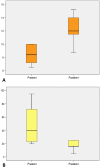The outcome of percutaneous stent implantation in congenital heart disease: experience of a single institute
- PMID: 29963102
- PMCID: PMC6021364
- DOI: 10.3345/kjp.2018.61.6.187
The outcome of percutaneous stent implantation in congenital heart disease: experience of a single institute
Abstract
Purpose: The efficacy of percutaneous stent implantation for congenital heart disease (CHD) in Korea, where stent availability is limited, has not been determined. This study evaluated the acute and midterm results of stent implantation in different CHD subgroups.
Methods: Stents were implanted in 75 patients with 81 lesions: (1) pulmonary artery stenosis (PAS) group, 56 lesions in 51 patients; (2) coarctation of the aorta (CoA) group, 5 lesions in 5 patients; (3) Fontan group, 13 lesions in 12 patients; (4) ductal stent group, 3 lesions in 3 patients; and (5) other CHD group, 4 lesions in 4 patients. Mean follow-up duration was 2.1 years (0.1-4 years). Medical records were reviewed retrospectively.
Results: The minimum lumen diameter (MLD) in PAS and CoA increased from 5.0±1.9 mm and 8.4±1.6 mm to 10.1±3.6 mm and 12.3±2.5 mm, respectively (P<0.01). In the PAS group, pressure gradient decreased from 25.7±15.6 mmHg to 10.4±10.1 mmHg, and right ventricular to aortic pressure ratio from 0.56±0.21 to 0.46±0.19. In the CoA group, the pressure gradient decreased from 50±33 mmHg to 17±8 mmHg. In the ductal stent group, the MLD of the ductus increased from 2.3 mm to 4.3 mm and arterial oxygen saturation from 40%-70% to 90%. No deaths were associated with stent implantation. Stent migration occurred in 3 patients, but repositioning was successful in all. Stent redilation was performed successfully in 26 cases after 29±12 months.
Conclusion: Percutaneous stent implantation was safe and effective, with acceptable short and mid-term outcomes in Korean CHD patients.
Keywords: Congenital heart disease; Mid-term outcome; Percutaneous stent implantation.
Conflict of interest statement
Conflicts of interest: No potential conflict of interest relevant to this article was reported.
Figures




Similar articles
-
[Therapeutic effect of Cheatham-Platinum stent implantation for vessel stenosis associated with congenital heart disease in children and adolescents].Zhonghua Er Ke Za Zhi. 2009 Apr;47(4):255-9. Zhonghua Er Ke Za Zhi. 2009. PMID: 19555561 Chinese.
-
Midterm to long-term safety and efficacy of self-expandable nitinol stent implantation for coarctation of aorta in adults.Catheter Cardiovasc Interv. 2017 Sep 1;90(3):425-431. doi: 10.1002/ccd.27178. Epub 2017 Jul 14. Catheter Cardiovasc Interv. 2017. PMID: 28707350
-
Management of percutaneous treatment of aorta coarctation diagnosed during pregnancy.J Med Life. 2022 Feb;15(2):208-213. doi: 10.25122/jml-2021-0363. J Med Life. 2022. PMID: 35419094 Free PMC article.
-
Stenting in congenital heart disease: medium- and long-term outcomes from the JPIC stent survey.Circ J. 2010 Aug;74(8):1676-83. doi: 10.1253/circj.cj-10-0157. Epub 2010 Jun 29. Circ J. 2010. PMID: 20595775
-
Percutaneous stent implantation for occluded central shunts in adults: A case report and review of current evidence.Front Cardiovasc Med. 2022 Nov 21;9:1032974. doi: 10.3389/fcvm.2022.1032974. eCollection 2022. Front Cardiovasc Med. 2022. PMID: 36479575 Free PMC article. Review.
Cited by
-
Selective iliofemoral stent placement for complex pediatric cases: a decade of institutional experience.Pediatr Radiol. 2024 Aug;54(9):1540-1548. doi: 10.1007/s00247-024-05985-7. Epub 2024 Jul 11. Pediatr Radiol. 2024. PMID: 38987429
References
-
- Shaffer KM, Mullins CE, Grifka RG, O'Laughlin MP, McMahon W, Ing FF, et al. Intravascular stents in congenital heart disease: short- and long-term results from a large single-center experience. J Am Coll Cardiol. 1998;31:661–667. - PubMed
-
- Tomita H, Nakanishi T, Hamaoka K, Kobayashi T, Ono Y. Stenting in congenital heart disease: medium- and long-term outcomes from the JPIC stent survey. Circ J. 2010;74:1676–1683. - PubMed
-
- Law MA, Breinholt JP, 3rd, Shamszad P, Justino H, Mullins CE, Ing FF. The outcome of pulmonary artery stents following surgical manipulation. Catheter Cardiovasc Interv. 2011;77:390–394. - PubMed
LinkOut - more resources
Full Text Sources
Other Literature Sources

